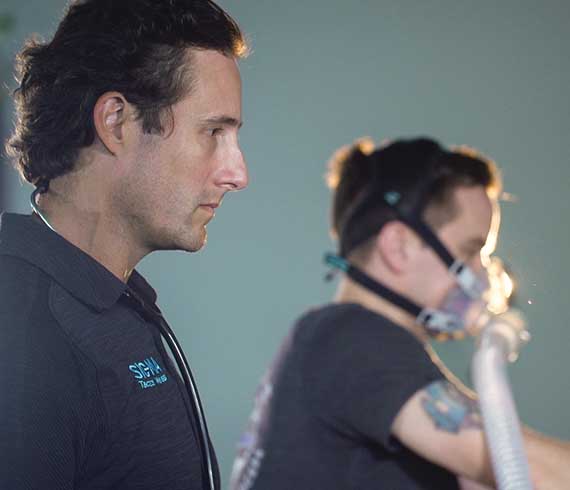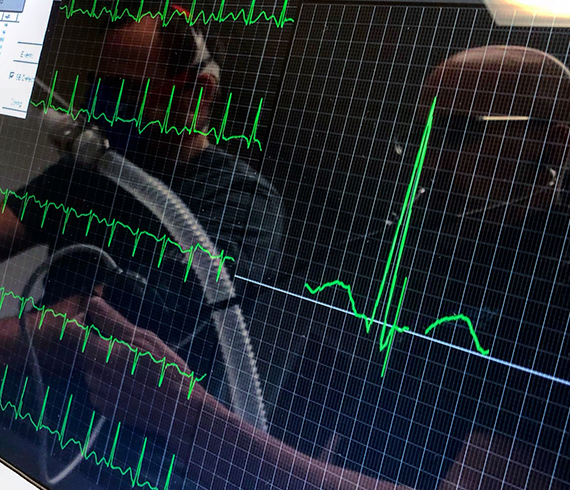Law enforcement professionals and first responders are at an increased risk when it comes to heart attacks and other cardiovascular issues. AccordingRead more
Photo of model shown

Photo of model shown

Sigma has developed a comprehensive and cutting-edge program which has been proven superior to traditional cardiovascular risk analysis and coronary artery calcium scoring. Our programs, either though Sigma OnSite or remote via HeartStart, offer the diagnostic tools to identify individuals who are at high risk for a cardiovascular event.
Photo of actual patient shown
Year after year, one of the top killers of active and retired law enforcement officers is cardiovascular disease. The average age of a police officer suffering a heart attack is 46 years old and the life expectancy of men and women in uniform is more than 20 years less than the civilian population1. Published data shows that, between the ages of 55 and 60, the chance of a civilian dying from a heart attack is 1.6%. However, within populations of police officers, it is 56%.1 Through our state-of-the-art preventative screening technology, we have proven that over 90% of officers tested who were considered to be low risk through traditional screening methods were actually found to be at high risk for a cardiovascular event.2
Police officers suffer from obesity, diabetes and hypertension at rates that are much higher than their civilian counterparts. National statistical data shows that the obesity rate for police officers is 48% which is 8% higher than what is seen in the civilian sector.3 The rampant obesity epidemic creates concomitant diabetes, high blood pressure, sleep disorders, and significant musculoskeletal issues such as chronic back, knee, and hip pain.
1John M. Violanti, Tara A. Hartley, et al., “Life Expectancy in Police Officers: A Comparison with the U.S. General Population,” International Journal of Emergency Mental Health 15, no. 4 (2013): 217–28.
2 Sheinberg et al, “Liposomal Associated Phospholipase A2 is More Effective in Predicting Cardiac Risk in Law Enforcement Than Framingham Risk Score and Coronary Artery Calcium Score Calculation”. JOEM, PAP Jan 2, 2024.
3 (Univ. Buffalo NY 2012)
Testimonials appearing on this website represent the views of the participant and his/her individual experience. Sigma is not responsible for inaccuracies or omissions by the individuals. Results may vary by participant. We do not claim that all participants in our program will have similar results. Persons giving testimonials may have been compensated with free services or discounts in exchange for sharing their experience.
Photo of actual patient shown
Sigma offers a comprehensive cardiac screening evaluation which includes vascular imaging, advanced lipid testing, and inflammatory biomarker analysis which has been proven effective in detecting the early stages of cardiovascular disease. In addition with our OnSite program, a cardiopulmonary exercise stress test is performed on a stationary bicycle to measure functional capacity and to identify any ischemia that may be present. The generated data is used to identify cardiac risk and allows our clinicians to develop individualized exercise and nutritional recommendations.
For a population of 100 police officers, based on our observed statistics, roughly 50 will have evidence of coronary artery disease, 40-80 will be clinically obese and approximately 30 will have evidence of undiagnosed hypertension and or diabetes.4
If assuming only 10% of the 50 officers with detected blockages will progress to develop a heart attack within 5 years (low estimate) total cost to the tax payers ranges between $2 million to $3.75 million dollars. (Currently, the costs of an on- or off-duty heart attack range from $400,000 to $750,000)4
If the cost of untreated obesity is factored into the five-year cost, there is an additional $1.22 million associated with overall health care, workman’s’ compensation, and disability cost.4
Total Cost Savings (100 officers)
$4.97 million over 5 years
4 Cawley J, Meyerhoefer C. The medical care costs of obesity: an instrumental variables approach. J Health Econ. 2012; 31:219-30.

Photo of actual patient shown

We have also documented other substantial cost savings from our program. The Colorado Inter-Governmental Risk Sharing Agency (CIRSA, Denver CO) has identified substantial reductions in workers’ compensation claims for individuals who have participated in our program. Furthermore, a large metropolitan city in Southern Texas has realized a 72% reduction in cardiovascular claims in those going through our screening process.6
6 https://www.linkedin.com/pulse/sigma-tactical-wellness-saving-lives-reducing-costs-jonathan/
Photo of model shown

Sigma began with the desire to create efficient avenues for members of public safety seeking a greater measure of health and performance from their daily lives. Today, we have served more than 15,000 emergency responders in the United States.
Law enforcement professionals and first responders are at an increased risk when it comes to heart attacks and other cardiovascular issues. AccordingRead more
Eat a balanced diet New Year’s Eve. Make sure you eat regular meals and snacks in order to satiate your appetite priorRead more
Quite simply, I have never been confronted by a more constant and seemingly endless debate than the use of power data vsRead more
“Go hard or go home”. How many times have you heard that pedantic statement? Probably too many to count, I’m sure. Normally,Read more
When one considers a strategy for supplying the body with what it needs for any type of sustained activity (by sustained, IRead more
Cyclists are a different breed, I grant you, but until you hear them (alright, US — you got me…) speak about theirRead more
Since the advent of mainstream ventilatory data collection, VO2max, for some reason, has been the quintessential bit of information that makes anRead more
One of the most interesting attributes, I find, regarding cyclists, triathletes, and runners is that they spend thousands of dollars and countlessRead more
Recently, while in my local bike shop I found myself paying some serious attention to my favorite category of products- Recovery supplements.Read more
When given the choice between deep, rhythmic, more diaphragmatic breathing, or short rapid almost hyperventilatory breaths, it is almost instinctive to thinkRead more
The elaborateness of VO2max testing is to some people a luxurious non-necessity reserved only for people with western European accents or forRead more